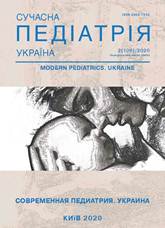Melatonin- and cortisol-producing function in children with chronic gastroduodenitis and primary arterial hypertension
Keywords:
chronicgastro duodenitis, arterial hypertension, combined pathology, melatonin, cortisolAbstract
Research aim: to characterize the exchange of melatonin and cortisol in children with concomitant chronic gastroduodenitis (CGD) and primary arterial hypertension (PAH).
Materials and methods. We examined 101 children aged 14 to 17 years. first group consisted of 30 children with a combination of CGD and PAH, the second group — 33 children with CGD and normal blood pressure (BP), the third group — 38 healthy children. The levels of «free» cortisol (FC) and 6-sulfatoxymelatonin (6-SOMT) were evaluated in daytime and nighttime urine.
Results. Compared with healthy children, the concentrations of FC and 6-SOMT during the day were higher in patients of both clinical groups. At night FC was higher in comparison with healthy children only in the first group (p<0.05). The nighttime level of 6-SOMT did not significantly differ from healthy children. However, in comparison with the second group, patients of the first group had a higher level of daytime FC (p=0.03) and a tendency to a decrease in nighttime excretion of 6-SOMT (p=0.05). The most pronounced circadian disorders of 6-SOMT and FC excretion were formed during erosive changes in the gastric mucosa and duodenum, especially when combined with PAH.
Conclusions. In children with combined course of PAH and CGD significantly changed in the urine indicators of 6-COMT and FC, than in healthy and patients with CGD. Such changes are more pronounced with erosive lesions of the gastric mucosa.
The research was carried out in accordance with the principles of the Helsinki Declaration. The study protocol was approved by the Local Ethics Committee of all participating institution. The informed consent of the patient was obtained for conducting the studies.
References
Vapaev KB, Irnazarov ShO. (2019). Rol melatonina v regulyacii funkcii zheludochno-kishechnogo trakta. Sovremennye innovacii. 1(29): 32—39.
Vahrushev YaM, Busygina MS, Danilova OV. (2016). Opyt lecheniya bolnyh yazvennoj boleznyu s soputstvuyushej hronicheskoj duodenalnalnoj nedostatochnostyu. Arhiv vnutrennej mediciny. 7(6): 455—61.
Hyshchak TV. (2014). Patohenetychna rol melatoninu i kortyzolu u formuvanni pervynnoi arterialnoi hipertenzii u dytiachomu vitsi. Aktualni pytannia pediatrii, akusherstva i hinekolohii. 1: 67—69
Ionov YaM. (2016). Mehanizmy erozivnogo porazheniya zheludka i dvenadcatiperstnoj kishki u detej. Nacionalnaya associaciya uchenyh (NAU). 5(21): 97—8.
Koreniev MM, Kamarchuk LV, Kvaratskheliia TM. (2014). Vmist melatoninu v pidlitkiv zi shlunkovoiu dyspepsiieiu, asotsiiovanoiu z CagA Helicobacter pylori infektsiieiu. Ukrainskyi zhurnal dytiachoi endokrynolohii.1: 22—6.
Marushko YuV. Hyshchak TV. (2014). Systemni mekhanizmy adaptatsii. Stres u ditei. Kyiv-Khmelnytskyi: Pryvatna drukarnia FO-P Storozhuk OV: 140.
Marushko YuV, Marushko TV, Artemenko YeO, Volosovets OP et al. (2018). Kardyolohiia dytiachoho viku. Kyiv-Khmelnytskyi: Pryvatna drukarnia FO-P Storozhuk OV: 528.
Panova IV, Afonina TA, Dombayan SH. (2014). Izmenenij kortizola i somatotroponogo gormona u detej s helicobacter pylori-associirovannym hronicheskim gastroduodenitom v sochetanii s gastroezofagealnoj reflyuksnoj boleznyu. Sovremennye problem nauki i obrazovaniya. 4: 347—352.
Poplavec EV. (2017). Ocenka pokazatelej transformiruyushego faktora rosta beta 1 i kortizola v syvorotke krovi y unoshej i molodyh muzhchin pri gastroduodenalnoj patologii. Vestnik Vitebskogo gosudarstvennogo medicinskogo universiteta.16(1): 33—43.
Baker J, Kimpinski K. (2018). Role of melatoninin blood pressure regulation: Anadjunctanti-hypertensiveagent. Clinical and Experimental Pharmacology.45(8): 7557—66. https://doi.org/10.1111/1440-1681.12942; PMid:29603319
Cipolla-Neto J, Amaral FGD. (2018). Melatonin as a Hormone: New Physiological and Clinical Insights. Endocr Rev.39(6): 990—1028. https://doi.org/10.1210/er.2018-00084; PMid:30215696
De Talamoni NT, Areco V, Rodriguez V, Marchionatti A, PerezA. (2017). Melatonin, Gastrointestinal Protection, and Oxidative Stress. Gastrointestinal Tissue Oxidative Stress and Dietary Antioxidants: 317—325. https://doi.org/10.1016/B978-0-12-805377-5.00025-4
Luo J, Song J, Zhang H, Zhang F et al. (2018). Melatonin mediated Foxp3-downregulation decreases cytokines production via the TLR2 and TLR4 pathways in H. Pylori infected mice. International Immunopharmacology. 64: 116—122. https://doi.org/10.1016/j.intimp.2018.08.034; PMid:30173051
Mazgelyte E, Karciauskaite D, Linkeviciute A, Mazeikiene A et al. (2019). Cortisol Concentration with Prevalence of Major Cardiovascular Risk Factors and Allostatic Load. Med Sci Monit.25: 3573—3582. https://doi.org/10.12659/MSM.913532; PMid:31086129 PMCid:PMC6530440
Pal P, Bhattacharjee B, Chattopadhyay A, Bandyopadhyay D. (2019). Melatonin as an armament against non8steroidal anti-inflammatory drug induced gastric injury: An overview. Melatonin Research. (2): 115—137. https://doi.org/10.32794/mr11250015
Downloads
Published
Issue
Section
License
The policy of the Journal “MODERN PEDIATRICS. UKRAINE” is compatible with the vast majority of funders' of open access and self-archiving policies. The journal provides immediate open access route being convinced that everyone – not only scientists - can benefit from research results, and publishes articles exclusively under open access distribution, with a Creative Commons Attribution-Noncommercial 4.0 international license (СС BY-NC).
Authors transfer the copyright to the Journal “MODERN PEDIATRICS. UKRAINE” when the manuscript is accepted for publication. Authors declare that this manuscript has not been published nor is under simultaneous consideration for publication elsewhere. After publication, the articles become freely available on-line to the public.
Readers have the right to use, distribute, and reproduce articles in any medium, provided the articles and the journal are properly cited.
The use of published materials for commercial purposes is strongly prohibited.

